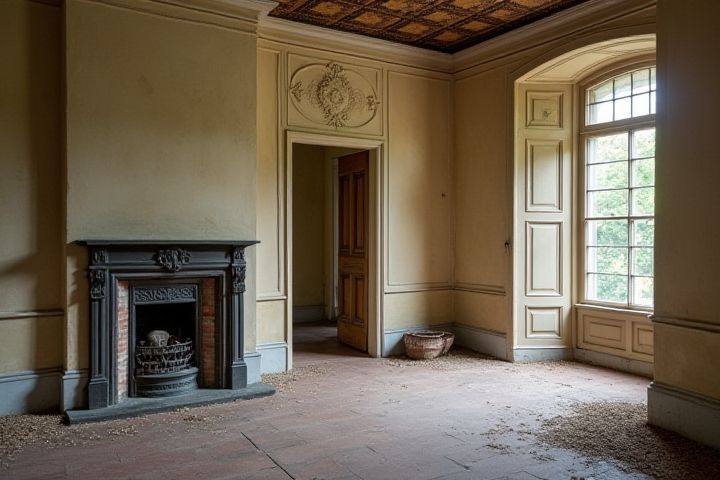
Renovating a historic house preserves its architectural integrity while enhancing its functionality and comfort. These homes often feature unique craftsmanship, such as intricate woodwork and distinctive masonry, that reflects the cultural heritage of their time. By updating outdated electrical systems and plumbing, you can increase energy efficiency and safety without compromising the original character. Renovation can also significantly boost the property's market value, making it a sound investment. Embracing sustainability through adaptive reuse allows you to honor history while promoting environmentally responsible living.
Why Renovate A Historic House
Preserve architectural heritage
Renovating a historic house is essential for preserving architectural heritage, as it maintains the unique design elements and craftsmanship that reflect the era in which the structure was built. By restoring original features such as moldings, windows, and doors, you contribute to the cultural narrative of your community and showcase the artistry of past generations. Historic renovations often incorporate sustainable practices, enabling you to reduce environmental impact while honoring the building's integrity. Furthermore, preserving these structures fosters a sense of identity and continuity, enhancing local property values and enriching the cultural landscape.
Increase property value
Renovating a historic house can significantly increase its property value, often fetching up to 20% more than non-historic properties in the same area. Preserving original architectural features, such as crown molding and hardwood floors, enhances aesthetic appeal, attracting buyers who appreciate historical significance. Modern upgrades, including energy-efficient windows and updated plumbing, not only improve comfort but also align with current market demands, further boosting potential resale prices. By investing in these renovations, you enhance both the charm and marketability of your property, creating a long-term asset with enduring value.
Enhance energy efficiency
Renovating a historic house with a focus on enhancing energy efficiency can significantly reduce utility costs while preserving its architectural integrity. Upgrading insulation, windows, and HVAC systems can lead to improved climate control and comfort without compromising the home's historical charm. By incorporating energy-efficient materials and technologies, you contribute to sustainability and environmental stewardship. These improvements not only benefit your household budget but also increase the property's value and appeal in today's eco-conscious market.
Ensure structural integrity
Renovating a historic house is crucial to ensure structural integrity, as many older homes may experience significant wear and tear over the decades. Inspecting foundational elements, such as beams and joists, can identify potential weaknesses that compromise safety and longevity. Preserving historical features while reinforcing structural components can enhance both your home's resilience and value. Investing in professional assessments and quality materials ensures your renovation meets modern safety standards while respecting the building's heritage.
Modernize amenities
Renovating a historic house allows you to blend timeless charm with contemporary functionality, enhancing the property's appeal and livability. By modernizing amenities such as plumbing, electrical systems, and HVAC, you create a comfortable environment without compromising the building's architectural integrity. Upgrading kitchens and bathrooms with modern fixtures and energy-efficient appliances not only improves daily convenience but also increases the home's market value. You preserve the historical significance while making the space more suited to today's lifestyle, ensuring it remains relevant and attractive to future generations.
Customize living spaces
Renovating a historic house allows you to personalize living spaces while preserving unique architectural features. By integrating modern amenities with original elements such as crown molding or hardwood floors, you create a harmonious blend of old and new. Customization can reflect your personal style, transforming rooms into functional areas tailored to your lifestyle, such as a home office or a gourmet kitchen. This thoughtful approach not only enhances your living experience but also adds value to the property in the long run.
Revitalize neighborhoods
Renovating a historic house can significantly revitalize neighborhoods by preserving architectural heritage while promoting community engagement. Such projects often lead to an increase in property values, with studies showing that well-maintained historic homes can enhance nearby real estate by up to 20%. Additionally, revitalization attracts new businesses and can boost local economies, creating job opportunities and fostering a vibrant community atmosphere. When you invest in renovation, you not only restore a piece of history but also reinvigorate the social fabric of your neighborhood.
Foster community pride
Renovating a historic house fosters community pride by preserving local heritage and architectural character, thereby creating a tangible connection to the past. Engaging community members in the renovation process promotes collaboration and investment in shared spaces, strengthening neighborhood bonds. A revitalized historic property often enhances property values and stimulates local economies, attracting businesses and visitors. By showcasing history, you contribute to a sense of identity that resonates with current and future generations, ensuring that the narrative of the community remains vibrant and engaged.
Access potential tax benefits
Renovating a historic house can provide access to various potential tax benefits, such as the federal historic tax credit, which allows you to claim a percentage of the rehabilitation costs. Local and state governments often offer incentives, grants, or reduced property taxes for preserving historic properties, encouraging you to invest in restoration projects. Maintaining the unique architectural features and historical integrity of these structures not only enhances their value but can also qualify for additional financial assistance. Investing in a historic home fosters community heritage, while simultaneously benefitting your financial situation through strategic tax deductions.
Attract niche buyers.
Renovating a historic house can attract niche buyers who value authenticity and character in their homes. Approximately 60% of potential buyers express a preference for unique architectural features, which are often found in older properties. By preserving original elements, such as hardwood floors and vintage fixtures, you enhance the home's appeal and increase its market value--sometimes up to 20%. Moreover, niche buyers often seek properties in heritage-listed neighborhoods, where a renovated historic house can stand out in a competitive real estate market.
